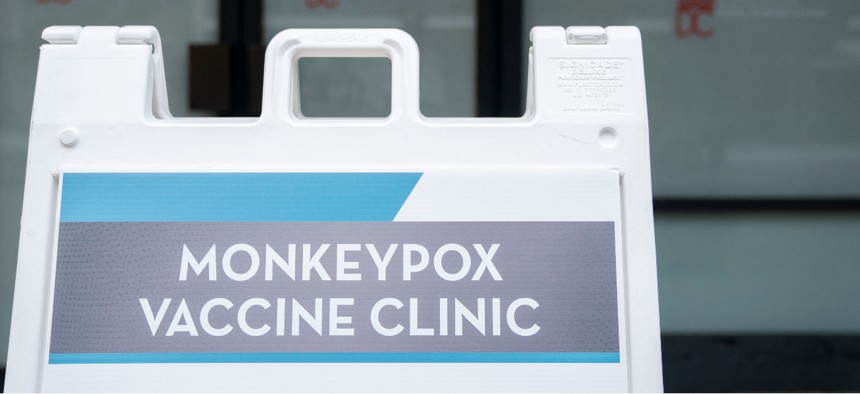
The Biden administration declared monkeypox a national public health emergency last week. STEFANI REYNOLDS/AFP via Getty Images)
Biden's Monkeypox Response Coordinator Says HHS’ New Dose-Sparing Vaccine Strategy is a Game Changer
Federal public health officials expect to increase the vaccine availability by up to five-fold.
The Health and Human Services Department took action this week to make additional monkeypox vaccines available amid growing demand as the virus continues to spread throughout the country.
On Tuesday, the Food and Drug Administration issued an emergency use authorization for the JYNNEOS vaccine to allow healthcare personnel to administer one-fifth of the vaccine dose intradermally, which means the vaccine is injected in between the layers of the skin, as opposed to under the skin. The agency says this will increase the number of vaccine doses available by up to five-fold. This comes after the department declared monkeypox a national public health emergency last week, which unlocked more resources and authorities for the federal government’s response to the outbreak.
“In recent weeks the monkeypox virus has continued to spread at a rate that has made it clear our current vaccine supply will not meet the current demand,” Dr. Robert Califf, FDA commissioner, said in a statement on Tuesday. “The FDA quickly explored other scientifically appropriate options to facilitate access to the vaccine for all impacted individuals. By increasing the number of available doses, more individuals who want to be vaccinated against monkeypox will now have the opportunity to do so.”
In order to allow this strategy to be implemented, HHS had to issue a determination under section 564 of the Federal Food, Drug and Cosmetic Act to allow the FDA to alter how the vaccines are administered.
Since this plan may be unfamiliar to some health care providers, the Centers for Disease Control and Prevention is releasing a slew of resources starting on Tuesday in addition to making experts available to answer questions. Public health officials stressed on a briefing call on Tuesday that the new strategy will not compromise safety or efficacy of the vaccine.
CDC Director Dr. Rochelle Walensky said by using this new strategy, “not only do we have more doses, but we actually allow people to get two doses…so that they get the protection that they need.”
As of Aug. 8, there have been almost 9,000 reported cases of monkeypox/orthopoxvirus (family of viruses monkeypox belongs to), in the United States, according to the CDC’s data.
Bob Fenton, who was recently named as the White House national monkeypox response coordinator, described this new strategy as a game changer and said it is part of the whole-of-government response to the monkeypox outbreak, which started in May.
Dr. Scott Gottlieb, who served as FDA commissioner from May 2017 to April 2019, tweeted that “there’s a lot of precedent for intradermal delivery of vaccines to extend supply in public health emergencies," such as for yellow fever and Ebola.
“This is a reasonable move based on solid data. Challenges will be local delivery issues,” he continued. “Good planning can help mitigate them.”
Philip Krause, consultant to the World Health Organization and former deputy director at the FDA’s Office of Vaccines Research and Review, and Luciana Borio, senior fellow for global health at the Council on Foreign Relations, and former director for medical and biodefense preparedness policy at the National Security Council, wrote in Stat News that this strategy “could begin to address a public health need for men who have sex with men, who are at higher risk for acquiring the infection,” but it could also “backfire.”
They argued that “the U.S. needs a concerted effort to make sure enough vaccines and therapeutics are available to address these needs and to reduce suffering. A hasty decision to try an unproven and risky strategy to stretch the existing vaccine supply may interfere with developing a national plan to quell this outbreak.”
The emergency use authorization issued on Tuesday also allows for the vaccine to be used in individuals under the age of 18 through subcutaneous injection, meaning under the skin, which comes as more children have been exposed to the virus.
Dr. Peter Marks, director of the FDA’s Center for Biologics Evaluation and Research, said the vaccine will be administered this way, as it was originally, intended because they don’t have the same data for children as they do adults, also intradermal injections for young kids are often a little more challenging, so operationally, is more familiar and similar.
The White House said in fact-sheet, that “even with the alternative vaccine administration, the [HHS’s] Administration for Strategic Preparedness and Response will proceed with its procurement of 5.5 million vials of vaccine, which, factoring in the alternative dosing regimen, represents as much as 25 million doses that will become in the United States, in addition to current vaccine supply.” So far, HHS has made over 1.1 million doses of the JYNNEOS vaccine available to order and has shipped out more than 620,000 doses, to-date, department officials said on Tuesday.







